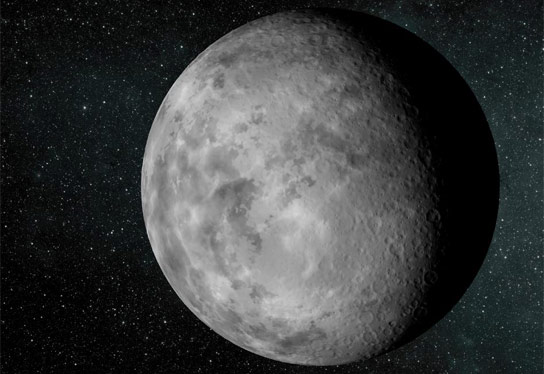Moon
Moon

NASA’s Kepler mission has discovered a new planetary system that is home to the smallest planet yet found around a star like our sun, approximately 210 light-years away in the constellation Lyra. The line up compares the smallest known planet to the moon and planets in the solar system. Kepler-37b is slightly larger than our moon, measuring about one-third the size of Earth. Kepler-37c, the second planet, is slightly smaller than Venus, measuring almost three-quarters the size of Earth. Kepler-37d, the third planet, is twice the size of Earth. A “year” on these planets is very short. Kepler-37b orbits its host star every 13 days at less than one-third the distance Mercury is to the sun. The other two planets, Kepler-37c and Kepler-37d, orbit their star every 21 and 40 days. All three planets have orbits lying less than the distance Mercury is to the sun, suggesting that they are very hot, inhospitable worlds. Image credit: NASA/Ames/JPL-Caltech
Researchers working on NASA’s Kepler mission have discovered a new planetary system called Kepler-37. The new planetary system is about 210 light-years from Earth in the constellation Lyra and is home to a planet about one-third the size of Earth, which makes it the smallest planet yet found around a star similar to our sun.
Moffett Field, California — NASA’s Kepler mission scientists have discovered a new planetary system that is home to the smallest planet yet found around a star similar to our sun.
The planets are located in a system called Kepler-37, about 210 light-years from Earth in the constellation Lyra. The smallest planet, Kepler-37b, is slightly larger than our moon, measuring about one-third the size of Earth. It is smaller than Mercury, which made its detection a challenge.
The moon-size planet and its two companion planets were found by scientists with NASA’s Kepler mission to find Earth-sized planets in or near the “habitable zone,” the region in a planetary system where liquid water might exist on the surface of an orbiting planet. However, while the star in Kepler-37 may be similar to our sun, the system appears quite unlike the solar system in which we live.
Astronomers think Kepler-37b does not have an atmosphere and cannot support life as we know it. The tiny planet almost certainly is rocky in composition. Kepler-37c, the closer neighboring planet, is slightly smaller than Venus, measuring almost three-quarters the size of Earth. Kepler-37d, the farther planet, is twice the size of Earth.
The first exoplanets found to orbit a normal star were giants. As technologies have advanced, smaller and smaller planets have been found, and Kepler has shown even Earth-size exoplanets are common.
“Even Kepler can only detect such a tiny world around the brightest stars it observes,” said Jack Lissauer, a planetary scientist at NASA’s Ames Research Center in Moffett Field, California. “The fact we’ve discovered tiny Kepler-37b suggests such little planets are common, and more planetary wonders await as we continue to gather and analyze additional data.”
Kepler-37’s host star belongs to the same class as our sun, although it is slightly cooler and smaller. All three planets orbit the star at less than the distance Mercury is to the sun, suggesting they are very hot, inhospitable worlds. Kepler-37b orbits every 13 days at less than one-third Mercury’s distance from the sun. The estimated surface temperature of this smoldering planet, at more than 800 degrees Fahrenheit (700 degrees Kelvin), would be hot enough to melt the zinc in a penny. Kepler-37c and Kepler-37d, orbit every 21 days and 40 days, respectively.

The artist’s concept depicts the new planet dubbed Kepler-37b. The planet is slightly larger than our moon, measuring about one-third the size of Earth. Kepler-37b orbits its host star every 13 days at less than one-third the distance Mercury is to the sun. Image credit: NASA/Ames/JPL-Caltech


Comments
Post a Comment